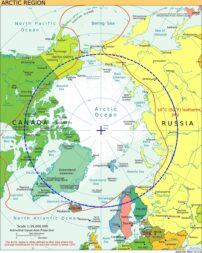The next wave of LEO infrastructure building should not be seen as individual satellites, but as always-on mesh networks.
Space is becoming more congested and communications all over the globe — but particularly in the Arctic region — are often contested.

Whether discussing Northern surveillance and NORAD modernization or the Enhanced Satellite Communication Project Polar (ESCP-P), governments are considering new infrastructure investments to meet defense mission requirements in these strategic locations.
But addressing these requirements doesn’t have to include building bespoke government networks. Several companies are investing billions of dollars in creating commercial satellite networks in low Earth orbit (LEO) and, with the right design, will be able to meet government needs. By clearly defining commercial space as part of their government space architecture and strategy, governments can in turn meet their urgent national security connectivity needs in the Far North through the proliferated architecture needed for resilient space operations.
Here’s a breakdown of why this is needed and how commercial networks designed with embedded security can meet government requirements:
CURRENT SHORTCOMINGS — AND WHAT GOVERNMENTS NEED
Current satellite connectivity has a number of shortcomings that prevent full global connectivity and are not at the standard that governments require. The first issue is coverage: geostationary (GEO) satellites, which account for most of the world’s connectivity today, are mostly at the equator and can’t “see” to the far north and south, allowing for “dead zones” of coverage. Cost is another challenge, as building the kind of network needed by governments from scratch is expensive.
Further, considering the sensitive nature of government and defense communications, secure and fast solutions are crucial. Traditional GEO satellites are more vulnerable because they operate at a single fixed point in the sky and can be compromised more easily, impacting critical operations. They also have higher latency, and in government and defense response, every millisecond counts.
WHERE DOES COMMERCIAL INNOVATION COME INTO PLAY?
Proliferated LEO networks are the solution to current shortcomings, including reaching into remote Northern areas, and present an opportunity for governments to leverage existing commercial investments that are already filling the gaps. Commercial LEO systems offer the ability to distribute national security communications through a variety of paths and spacecraft to provide a mesh network that is resistant to a single point of failure.
The next wave of LEO infrastructure building should not be seen as individual satellites, but emphatically as networks. Mesh networks, connected by inter-satellite links, allow continuous coverage of the Arctic: always-on, always-available connectivity which is suited to the national security importance of the Arctic mission. The minimum required technology includes satellites connected to other satellites in the mesh with high speed links, and onboard supercomputers to route messages at speed and volume.
This should also include interoperability between commercial and government satellites in order to dynamically and seamlessly respond to shifting needs; the capacity to deliver large amounts of throughput to specific areas; a lack of terrestrial touchpoints to mitigate security risks; and resiliency to ensure multiple satellites and communication paths are available from any point on Earth.
THE ANSWER TO ARCTIC CONNECTIVITY GAPS: PROLIFERATED SPACE ARCHITECTURE
Government and military programs around the world will be best served by including commercial space as an element in their security architecture, and looking to LEO networks that were designed for secure, enterprise-grade capacity and to reach the far Northern regions.
Companies are actively testing using this model, and the results speak for themselves; for example, DARPA’s Blackjack program, which recently moved into Phase 2 development and testing, and CASINO program are both working to demonstrate commercial LEO utility for defense communications. Other organizations such as the Space Development Agency are doing similar work, demonstrating commercial interoperability. Overall, initial testing and success seen in both Canada and the U.S. — two countries that regularly share in the business of Arctic connectivity — underscores the unique benefits of LEO networks for reaching these remote areas.
Tests like these further showcase how LEO networks can support government applications on a true global scale – and are a stark reminder of why governmental space architecture must be designed to include secure commercial LEO networks. Leveraging commercial LEO networks, governments can bridge connectivity gaps in the Arctic regions and establish secure and reliable communications channels for defense operations and threat assessment at scale.
James J. Shaw is Director, Government Solutions of Telesat U.S. Services.
This article originally appeared in the June 2021 issue of SpaceNews magazine.
#Space | https://sciencespies.com/space/op-ed-to-solve-for-arctic-connectivity-governments-need-a-network-suited-to-their-unique-needs/
No comments:
Post a Comment